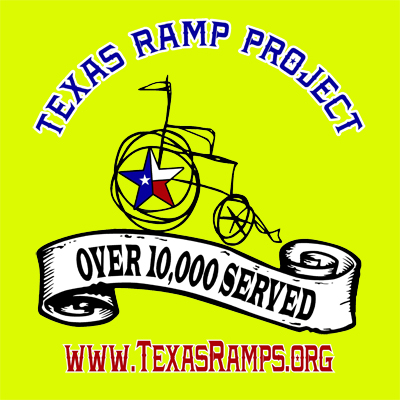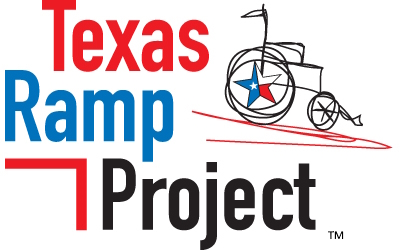 An elderly disabled man escapes his burning home on his new wheelchair ramp. A dialysis patient can finally leave her home without having to be carried down the steps. A stroke patient’s dangerously rotting ramp is removed and replaced with a new, safe one. A 7-year-old boy with cerebral palsy gets a ramp to accommodate his new special wheelchair.
An elderly disabled man escapes his burning home on his new wheelchair ramp. A dialysis patient can finally leave her home without having to be carried down the steps. A stroke patient’s dangerously rotting ramp is removed and replaced with a new, safe one. A 7-year-old boy with cerebral palsy gets a ramp to accommodate his new special wheelchair.
These are but a few of thousands of stories connected to the Texas Ramp Project, a statewide nonprofit that builds free wheelchair ramps for elderly and disabled people who can’t afford them on their own. The ramps are built by local volunteers. Last year this modern-day barn raising provided free ramps for more than 1,500 people across the state. So far this year TRP volunteers have built over 1,000 more ramps, on almost any given day of the week.
The Texas Ramp Project grew out of the Dallas Ramp Project, established by the Richardson Kiwanis 30 years ago. In 2006 John Laine, then manager of the Dallas Project, expanded the Dallas model across the state. Since then local Ramp Projects have been established in 31 Texas regions serving 190 Texas counties.
During the week of October 10–17, the Texas Ramp Project will celebrate construction of its 10,000th ramp. This milestone is achieved by combining the totals of the Texas Ramp Project and the Dallas Ramp Project, now a part of the statewide organization.
Costs are kept low because the Texas Ramp Project is essentially a volunteer organization. Laine, who serves as executive director, recruits team leaders and volunteers from local churches, service clubs, student and alumni groups and businesses. He trains and equips the volunteers to build ADA-compliant ramps that are safe, strong and durable.
Laine also introduces the program to funding sources and the local health care community. Referrals come from health care providers, social workers and local agencies—286 a month in 2014 and over 300 a month in the current year.
TRP’s innovative business model of using volunteer labor has held the average cost of a ramp to about $600, less than a third the cost of a ramp built by a for-profit builder. The ramps have brought improved quality of life, independence and safety to the clients and eased the burden on their caregivers, often elderly spouses. Ramps also allow clients to remain in their homes. A $600 wheelchair ramp can save taxpayers up to $80,000 a year for maintaining that client in a nursing facility at public expense.
Texas Ramp Project Fact Sheet
Year Established: 2006
Organization Address: P.O. Box 832065, Richardson, TX 75083-2065
Web Site: www.texasramps.org
Facebook Page: www.facebook.com/TexasRamps
Local Organizations: 31 regions incorporating 190 counties
Ramps Built: 1,538 in 2014; over 1,000 to date in 2015
Revenues: $848,205 in 2014
Budget: $885,000 in 2015
Referrals: 3,433 in 2014; current rate of referrals is 300+ per month
Approximate Number of Volunteers: 3,000
Mission Statement: The Texas Ramp Project is a 501(c)(3) nonprofit organization whose mission is to establish regional wheelchair ramp-building programs across Texas. The regional Ramp Projects provide free wheelchair ramps to elderly and disabled clients in need identified by local health care professionals. Ramps are built without regard to race, religion, ethnicity, age or gender.
Vision Statement: Our vision is that no Texas resident shall lack safe access to and from his or her home because of financial limitations.
Executive Director: John Laine
Laine spent over 36 years in sales and management for industrial and aerospace products, including 20 years in his own business. A member of the Kiwanis Club of Richardson, he served as volunteer director of the Dallas Ramp Project from 1989 to 2005, when he left to found the Texas Ramp Project as a separate nonprofit serving all of Texas. He has been executive director since 2006. He holds a bachelor’s degree in sociology from St. Lawrence University.
Texas Demographics
Nearly 2.9 million Texans—over one in 10—are age 65 or over, and 26.2% report a physical disability with ambulatory difficulty. Nearly 1.6 million Texans of all ages have a disability that may require a wheelchair or walker. With Texas’ poverty rate at 17.6%, it is likely that there are a large number of people who need safe access to their homes but lack the means to obtain it.
How to Get a Ramp
TRP does not accept direct referrals from clients or their families. Referrals must come from a third-party health care provider via the TRP website. The provider selects Client Referral Info on the home page and fills out the online referral form. The form is sent to the region coordinator. A trained surveyor will visit the client and design a ramp at the preferred entry/exit that is appropriate in length, slope and direction. Based upon the survey information, a volunteer construction crew led by a trained leader will then implement the design in about four to five hours.
